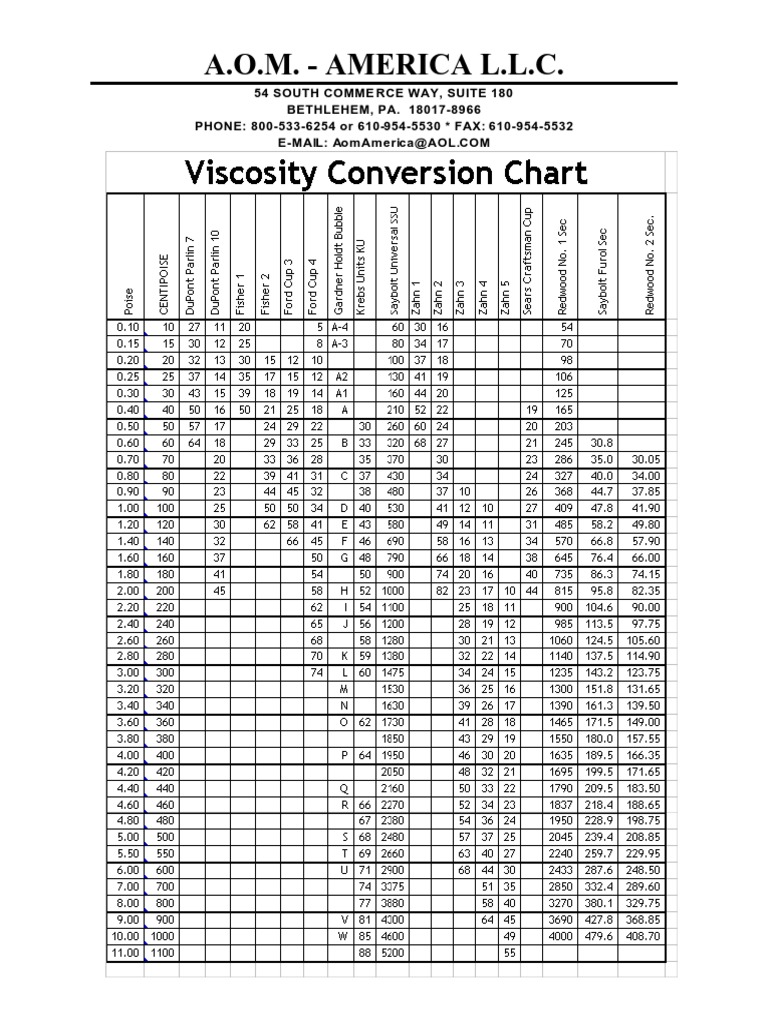Viscosity: Easy Unit Conversion

Understanding viscosity, a measure of a fluid’s resistance to flow, is crucial in various scientific and engineering applications. One of the key challenges in working with viscosity is converting between different units of measurement. Viscosity can be expressed in several units, including Poise (P), centiPoise (cP), Pascal-seconds (Pa·s), and centiStokes (cSt), among others. The ability to easily convert between these units is essential for accurate calculations and comparisons in fields such as chemistry, physics, and mechanical engineering.
Why Unit Conversion Matters
In scientific research and industrial applications, the accuracy of viscosity measurements can significantly impact the outcomes of experiments and the performance of systems. For instance, in the design of pipelines for oil transportation, understanding the viscosity of the oil and being able to convert it into appropriate units is crucial for calculating the required pumping power and predicting flow rates. Similarly, in chemical engineering, the viscosity of fluids is a critical parameter in the design of mixers, reactors, and separation equipment.
Basic Conversion Factors
To convert viscosity units, one must understand the basic conversion factors. The Poise (P) is a commonly used unit, where 1 P = 0.1 Pa·s. The centiPoise (cP) is one-hundredth of a Poise, making it 1 cP = 0.001 Pa·s. For kinematic viscosity, which is the ratio of dynamic viscosity to density, the unit Stokes (St) is used, where 1 St = 1 cm²/s = 10⁻⁴ m²/s. The centiStokes (cSt) is one-hundredth of a Stokes.
Conversion Formulas
Converting between units of viscosity involves simple multiplication or division by conversion factors. Here are some key conversions:
Poise to Pascal-seconds (Pa·s):
1 P = 0.1 Pa·s
To convert from Poise to Pa·s, multiply by 0.1.centiPoise (cP) to Pascal-seconds (Pa·s):
1 cP = 0.001 Pa·s
To convert from cP to Pa·s, multiply by 0.001.Pascal-seconds (Pa·s) to Poise (P):
1 Pa·s = 10 P
To convert from Pa·s to P, multiply by 10.Pascal-seconds (Pa·s) to centiPoise (cP):
1 Pa·s = 1000 cP
To convert from Pa·s to cP, multiply by 1000.Stokes (St) to centiStokes (cSt):
1 St = 100 cSt
To convert from St to cSt, multiply by 100.centiStokes (cSt) to Stokes (St):
1 cSt = 0.01 St
To convert from cSt to St, multiply by 0.01.
Practical Examples
Converting 500 cP to Pa·s:
Since 1 cP = 0.001 Pa·s,
500 cP = 500 * 0.001 Pa·s = 0.5 Pa·s.Converting 2 Pa·s to cP:
Since 1 Pa·s = 1000 cP,
2 Pa·s = 2 * 1000 cP = 2000 cP.Converting 10 St to cSt:
Since 1 St = 100 cSt,
10 St = 10 * 100 cSt = 1000 cSt.
Tools for Conversion
While manual conversion using the formulas above is straightforward, there are also numerous online viscosity conversion tools and calculators that can simplify the process. These tools allow users to input the value and unit they wish to convert from and then display the equivalent value in the desired unit. For frequent users or those dealing with a wide range of viscosity measurements, spreadsheet templates or custom calculator scripts can also be developed for quick and efficient conversions.
Conclusion
Unit conversion in viscosity measurements is a fundamental skill for anyone working in fields where fluid dynamics play a critical role. Understanding the conversion factors and being able to apply them accurately can significantly reduce errors in calculation and enhance the reliability of scientific and engineering projects. Whether through manual calculation, conversion tools, or automated scripts, easy and accurate unit conversion is indispensable for achieving precise results and advancing knowledge in viscosity-related studies.
What is the difference between dynamic and kinematic viscosity?
+Dynamic viscosity measures a fluid's resistance to flow under an applied force, usually expressed in Poise (P) or Pascal-seconds (Pa·s). Kinematic viscosity, on the other hand, is the ratio of dynamic viscosity to the fluid's density, expressed in Stokes (St) or centiStokes (cSt). It represents the fluid's resistance to flow due to gravity.
How do I convert between dynamic and kinematic viscosity units?
+To convert between dynamic and kinematic viscosity units, you need to know the density of the fluid. Kinematic viscosity (ν) is calculated as dynamic viscosity (μ) divided by density (ρ), so ν = μ / ρ. Conversely, dynamic viscosity can be found by rearranging the formula: μ = ν * ρ. Ensure that the units are consistent during these calculations.
Are there any online tools or software for viscosity unit conversion?
+Yes, there are numerous online viscosity conversion tools and calculators available. These range from simple web-based converters to more comprehensive software packages that can handle a variety of unit conversions, including viscosity. Some scientific calculators and spreadsheet programs like Excel also offer built-in functions or templates for viscosity unit conversions.
Advanced Considerations
In advanced applications, understanding the temperature and pressure dependence of viscosity is crucial. Many fluids exhibit significant changes in viscosity with temperature, and some may also be affected by pressure. For precise calculations, especially in industrial processes or high-accuracy scientific research, these factors must be taken into account. Additionally, the method of measurement can influence the viscosity value obtained, as different techniques (such as capillary viscometry, rotational viscometry, or falling ball viscometry) may yield slightly different results due to factors like shear rate effects.
For those delving deeper into viscosity studies or applying viscosity measurements in complex systems, exploring the theoretical foundations and experimental methodologies in more detail is advisable. This includes understanding the concepts of Newtonian and non-Newtonian fluids, where the viscosity can either remain constant or change with the shear rate, respectively. Non-Newtonian behavior is particularly relevant in biological fluids, polymers, and certain types of oils, where the viscosity can significantly impact the flow characteristics and processing conditions.
As research and technology continue to advance, the importance of accurate viscosity measurements and unit conversions will only grow, necessitating a deep understanding of both the fundamental principles and the practical applications of viscosity in various fields.


